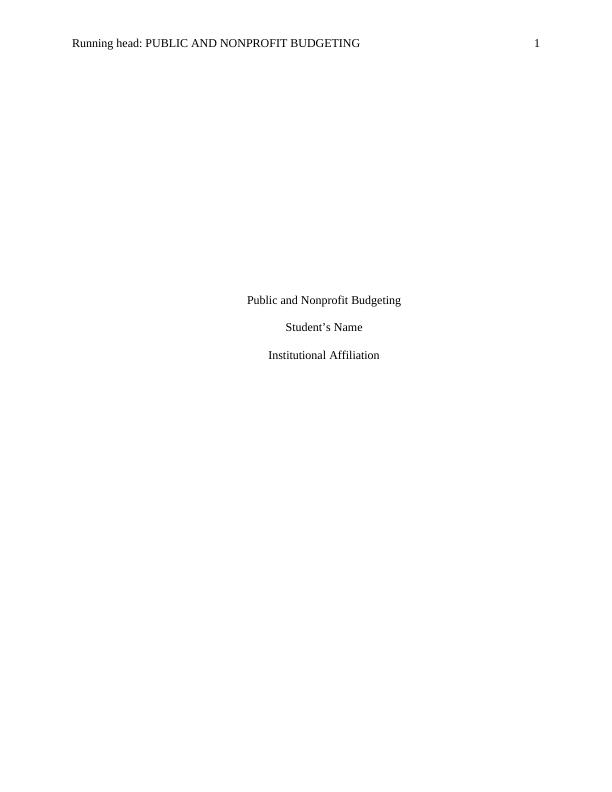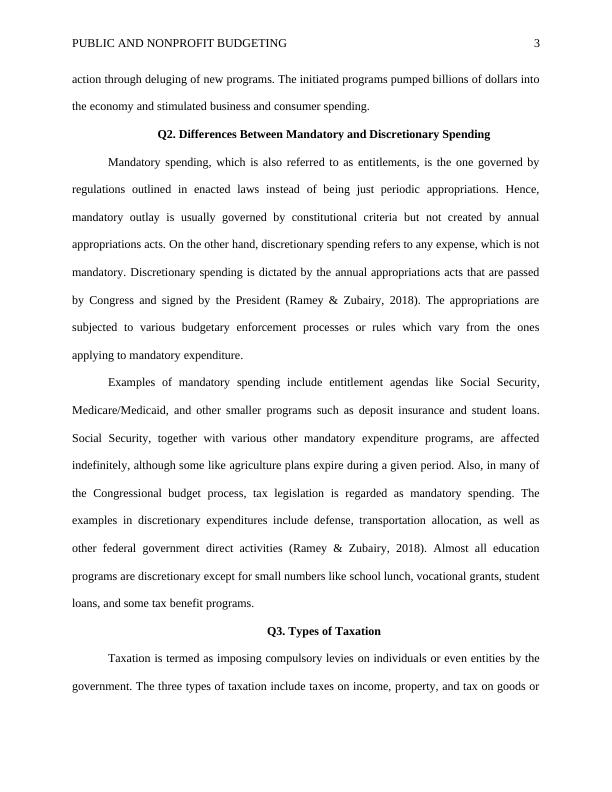Public and Nonprofit Budgeting Question Answer 2022
Added on 2022-10-03
7 Pages1554 Words14 Views
Running head: PUBLIC AND NONPROFIT BUDGETING 1
Public and Nonprofit Budgeting
Student’s Name
Institutional Affiliation
Public and Nonprofit Budgeting
Student’s Name
Institutional Affiliation

PUBLIC AND NONPROFIT BUDGETING 2
Public and Nonprofit Budgeting
Q1. Differences Between Monetary and Fiscal Policy
Monetary and fiscal strategy are the two key recognized tools which are used in
influencing a nation's economic activity. First, the monetary plan concerns with handling interest
rates as well as the entire money supply in the market. Monetary policy is generally carried out
by the country's chief banks like the US Federal Reserve.
On the other hand, fiscal policy refers to the joint term for government spending and
taxing actions. In the US, the legislative and executive arms of the government are the one which
determines the national fiscal policy. The other difference between the monetary and fiscal plan
is that the later ensures that the economy is developing and growing through government revenue
collection and appropriate expenditure (Ramey & Zubairy, 2018). In contrast, the monetary
policy provides liquidity in the marketplace and makes a country's economy stable throughout.
Besides, monetary policy is established concerning the country's economic conditions while the
fiscal policy is formed annually after a review of the previous year's results. Also, fiscal policy
encompasses a reasonable political influence, while the monetary policy is not associated with
any political power.
An example of both the monetary and fiscal policy can be seen during the great recession
when the US government and Federal Reserve initiated a multipronged response. The monetary
policy took place because the Fed had to respond to the financial crisis during the recession
period. Hence, the crisis emergence made the Fed implement various programs for the provision
of short-term liquidity while still purchasing large quantities of US Treasury and mortgage-
backed securities. On fiscal policy, the US treasury, executive, and legislative arms took a swift
Public and Nonprofit Budgeting
Q1. Differences Between Monetary and Fiscal Policy
Monetary and fiscal strategy are the two key recognized tools which are used in
influencing a nation's economic activity. First, the monetary plan concerns with handling interest
rates as well as the entire money supply in the market. Monetary policy is generally carried out
by the country's chief banks like the US Federal Reserve.
On the other hand, fiscal policy refers to the joint term for government spending and
taxing actions. In the US, the legislative and executive arms of the government are the one which
determines the national fiscal policy. The other difference between the monetary and fiscal plan
is that the later ensures that the economy is developing and growing through government revenue
collection and appropriate expenditure (Ramey & Zubairy, 2018). In contrast, the monetary
policy provides liquidity in the marketplace and makes a country's economy stable throughout.
Besides, monetary policy is established concerning the country's economic conditions while the
fiscal policy is formed annually after a review of the previous year's results. Also, fiscal policy
encompasses a reasonable political influence, while the monetary policy is not associated with
any political power.
An example of both the monetary and fiscal policy can be seen during the great recession
when the US government and Federal Reserve initiated a multipronged response. The monetary
policy took place because the Fed had to respond to the financial crisis during the recession
period. Hence, the crisis emergence made the Fed implement various programs for the provision
of short-term liquidity while still purchasing large quantities of US Treasury and mortgage-
backed securities. On fiscal policy, the US treasury, executive, and legislative arms took a swift

PUBLIC AND NONPROFIT BUDGETING 3
action through deluging of new programs. The initiated programs pumped billions of dollars into
the economy and stimulated business and consumer spending.
Q2. Differences Between Mandatory and Discretionary Spending
Mandatory spending, which is also referred to as entitlements, is the one governed by
regulations outlined in enacted laws instead of being just periodic appropriations. Hence,
mandatory outlay is usually governed by constitutional criteria but not created by annual
appropriations acts. On the other hand, discretionary spending refers to any expense, which is not
mandatory. Discretionary spending is dictated by the annual appropriations acts that are passed
by Congress and signed by the President (Ramey & Zubairy, 2018). The appropriations are
subjected to various budgetary enforcement processes or rules which vary from the ones
applying to mandatory expenditure.
Examples of mandatory spending include entitlement agendas like Social Security,
Medicare/Medicaid, and other smaller programs such as deposit insurance and student loans.
Social Security, together with various other mandatory expenditure programs, are affected
indefinitely, although some like agriculture plans expire during a given period. Also, in many of
the Congressional budget process, tax legislation is regarded as mandatory spending. The
examples in discretionary expenditures include defense, transportation allocation, as well as
other federal government direct activities (Ramey & Zubairy, 2018). Almost all education
programs are discretionary except for small numbers like school lunch, vocational grants, student
loans, and some tax benefit programs.
Q3. Types of Taxation
Taxation is termed as imposing compulsory levies on individuals or even entities by the
government. The three types of taxation include taxes on income, property, and tax on goods or
action through deluging of new programs. The initiated programs pumped billions of dollars into
the economy and stimulated business and consumer spending.
Q2. Differences Between Mandatory and Discretionary Spending
Mandatory spending, which is also referred to as entitlements, is the one governed by
regulations outlined in enacted laws instead of being just periodic appropriations. Hence,
mandatory outlay is usually governed by constitutional criteria but not created by annual
appropriations acts. On the other hand, discretionary spending refers to any expense, which is not
mandatory. Discretionary spending is dictated by the annual appropriations acts that are passed
by Congress and signed by the President (Ramey & Zubairy, 2018). The appropriations are
subjected to various budgetary enforcement processes or rules which vary from the ones
applying to mandatory expenditure.
Examples of mandatory spending include entitlement agendas like Social Security,
Medicare/Medicaid, and other smaller programs such as deposit insurance and student loans.
Social Security, together with various other mandatory expenditure programs, are affected
indefinitely, although some like agriculture plans expire during a given period. Also, in many of
the Congressional budget process, tax legislation is regarded as mandatory spending. The
examples in discretionary expenditures include defense, transportation allocation, as well as
other federal government direct activities (Ramey & Zubairy, 2018). Almost all education
programs are discretionary except for small numbers like school lunch, vocational grants, student
loans, and some tax benefit programs.
Q3. Types of Taxation
Taxation is termed as imposing compulsory levies on individuals or even entities by the
government. The three types of taxation include taxes on income, property, and tax on goods or

End of preview
Want to access all the pages? Upload your documents or become a member.
Related Documents
Managerial Economics: Fiscal Policy, Monetary Policy and Taxationlg...
|7
|851
|307
Expansionary and Contracting Fiscal Policieslg...
|20
|1058
|452
Global Financial Crisis - PDFlg...
|4
|1042
|36
Economics for Managers BUS702lg...
|5
|891
|135
Global Economy U.S. Case Study 2022lg...
|6
|1203
|16
BUS702 Economics for Managers: Assignmentlg...
|4
|704
|61
